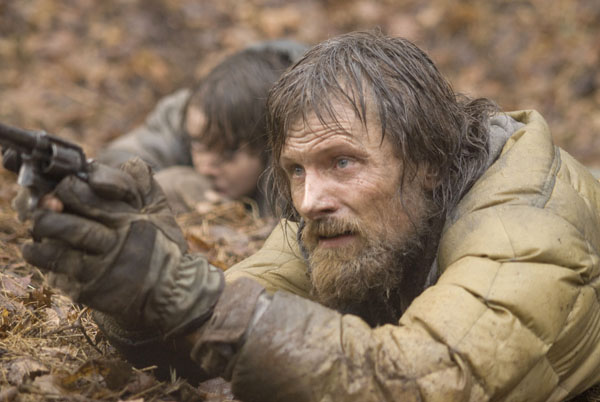|
Reviews of Recent Independent, Foreign, & Documentary Films in Theaters and DVD/Home Video

THE ROAD The Road, based on Cormac McCarthy’s 2006 best-selling novel (possibly the only Oprah book-of-the-month pick to feature widespread cannibalism), doesn’t entirely escape the modern page-to-screen curse. Though well-made and exciting, it often feels like a breathless signpost to the book’s major plot points. (“Hey remember this, it’s the scene with the old man!”) In both novel and film, an unnamed father and son travel through a barren American landscape blighted from a world-ending apocalypse to the coast—thinking that there they will perhaps find food and safety. McCarthy and the filmmakers, possibly taking a nod from Night of the Living Dead, rightly leave the disaster unexplained, tossing out hints (super-volcano, asteroid impact, nuclear war, some combination of the above) but tuning the focus to the personal drama, and ethics, of survival. Like the Buddhist parable of the man shot with a poisoned arrow: don’t worry about who shot it, just try to get it out. Even if the whole idea doesn’t completely hold together—no imaginable catastrophe would spare handfuls of survivors but leave all animals extinct, as the film implies—it looks great. With its grubby, desaturated landscapes, this is one of the truest-looking apocalypses on screen, thanks in part to the excellent use of locations, real scarred places, from treeless wastelands in the old coal mining country outside Pittsburgh to the urban mildewing of post-Katrina New Orleans. What differences there are between the book and film generally tend to favor the latter. Though McCarthy has suddenly become the Great Man of American Letters, I tend to side with B. R. Myers’s dissenting view in The Atlantic from a few years back. To me, McCarthy often reads like bad Hemingway, with his hyphenated, poeticized prose, and mythopoetic pretensions. The Road, with its nameless characters and Big Themes, just struck me as a post-apocalyptic version of The Old Man and the Sea; page turning, but a bit silly. While the namelessness of the father and son—referred to in the film simply as The Man and The Boy—comes across as an irritating gimmick in the book, it’s almost unnoticeable in the movie. The boy also seems a bit less priggish on screen, although the central struggle remains the same: the familiar one between the survival of humanity and the humanity of those who survive. The dad (Viggo Mortensen), with his hungry, fanatical love for his son, is an understandably ruthless, protect-the-boy-at-all costs survivalist, though he draws the line at cannibalism, the real mark of goodness in their damaged world. (However, the film subtly suggests that his suspicions of other survivors might actually prolong their suffering.) But The Boy (Kodi Smit-McPhee), nearly illiterate and born after the apocalypse began, is a bit naively, even miraculously, sappy and good-hearted. Rather than seeming like he’s nurturing the small flame of human virtue, he feels like a writer’s contrivance. Ever since Panic at Year Zero (a brilliant, unsung apocalypse yarn from the ’60s), these global catastrophe flicks always feature this rather airy conflict between survival and mercy, and it’s never gotten any more plausible. In keeping with the
high level of the production, the performances are great. Scrawny and
scruffy Mortensen, who lost weight for the role, carries the
film. The kid is good, too, though as children aren’t allow to method
act to the point of starvation, perhaps he looks a bit too healthy and
well-fed. The bit players—and aside from father and son, they’re all bit
players; this is a scenically wide open, but emotionally claustrophobic
tale—do well, even if the filmmakers give away their cultural
affiliations by peopling the cannibal gangs almost solely with rednecks.
Seen in one of the many flashbacks, Charlize Theron, The Man’s wife,
makes what to me is the sensible choice in a world full of state-size
fires and human-size dinners: she kills herself. Brendon Nafziger
|

